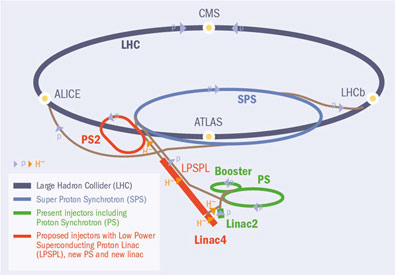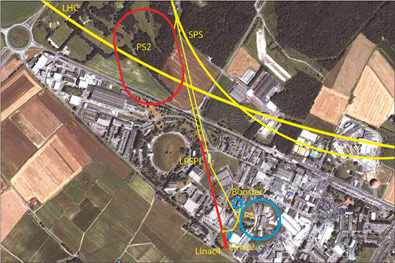The Super-LHC is on the starting blocks
Continue reading page | 1 | 2
Next in the present injector chain are the Booster and the PS, both of which suffer from inherent intensity limitations and reliability problems after many years of service. These both call for new injectors designed for the needs of the LHC, which also take into account potential future projects like a neutrino factory or a next-generation nuclear-isotope facility. Current plans concentrate on extending the energy of Linac4 to several giga-electron-volts (i.e. the LPSPL) and a new 50 GeV synchrotron called PS2, resulting in a higher performance – in particular, an increased SPS injection energy of 50 GeV and another doubling of the proton flux. Both machines are now entering the R&D and design-optimization stage, aiming for a decision on construction by 2011. The building of these new injectors can take place in parallel with operation of the LHC, with a changeover expected in 2017 after an extended shutdown.
In the LHC itself, major elements of the interaction regions in the two high-luminosity insertions can be replaced to give yet another luminosity gain of a factor of two. In particular, new focusing triplets based on Nb-Ti superconducting technology are forseen. Compared to the present systems they will have a larger aperture and will allow the beam size at the interaction point to be reduced. The new triplets will require parallel improvements in the LHC collimation system and the separation elements near the interaction regions, to be implemented before the 2013 physics run.
The ATLAS and CMS experiments will also require upgrades to increase their sensitivity limits in the presence of the higher interaction rates and increased radiation levels. At the SLHC, "pile-up" will amount to as many as 400 events per bunch crossing. This requires adapting trigger and data-acquisition schemes, as well as the complete replacement of the central tracking detectors. The new trackers will have finer granularity and an increased radiation hardness, while particular emphasis will be placed on minimizing their material budget. The forward muon regions will need major modifications, complemented by new beam-pipe elements and reinforced shielding.
While all of these technical developments towards the SLHC take place, LHC operation will continue uninterrupted and the LHC experiments will pursue their quest for new discoveries in the head-on collisions of protons and ions of extraordinarily high energy. In particular, these are expected to increase our knowledge of the origin of mass, the formation of matter, matter–antimatter asymmetries and issues such as extra dimensions of space, microscopic black holes and dark matter in the universe. Profiting from the successive luminosity increases, the SLHC will undoubtedly allow for further probing of phenomena first detected at the LHC. It will also provide better access to the detection of low-rate phenomena that will be inaccessible to the LHC, and will push the sensitivity limits for new physics processes to higher mass-scales.
Many R&D activities for the SLHC are now starting, thanks to several national funding sources, additional funding made available to CERN from its member states, and funding from the European Commission. The corresponding collaboration frameworks with worldwide partners are being established for the accelerators and for the experiments.
About the author
Lyn Evans and Lucie Linssen, CERN
Continue reading page | 1 | 2
April event kicks off for the SLHC
A public "kick-off" event, marking the start of SLHC developments, was held at CERN on 9 April. The aim was to inform a wide audience about the SLHC project. In a packed auditorium, the event began with a speech by CERN’s chief scientific officer, Jos Engelen. He emphasized the importance of developments towards the SLHC within the European particle physics strategy and commended the position taken up by SLHC activities within CERN’s overall programme. These will maintain the thrust of the numerous innovations accomplished for the design and implementation of the LHC, while working towards full exploitation of the LHC’s new physics. Engelen also reported on the role taken up by the LHC Committee in peer reviewing the R&D for the upgrade, and he encouraged the audience to submit their proposals.
The event continued with three overview talks. Michelangelo Mangano of CERN’s Theory Unit gave a talk on the present views on the physics potential of the SLHC – physics options that will become more refined as the LHC begins to reveal its secrets. Lyn Evans, LHC project leader, outlined the accelerator upgrade plans and associated timescales. Jordan Nash of Imperial College reported on the upgrade plans of both the ATLAS and CMS experiments. The event concluded with lively discussions on the impact of the announced gradual luminosity increases on the present physics, operation and upgrade plans of these experiments.






